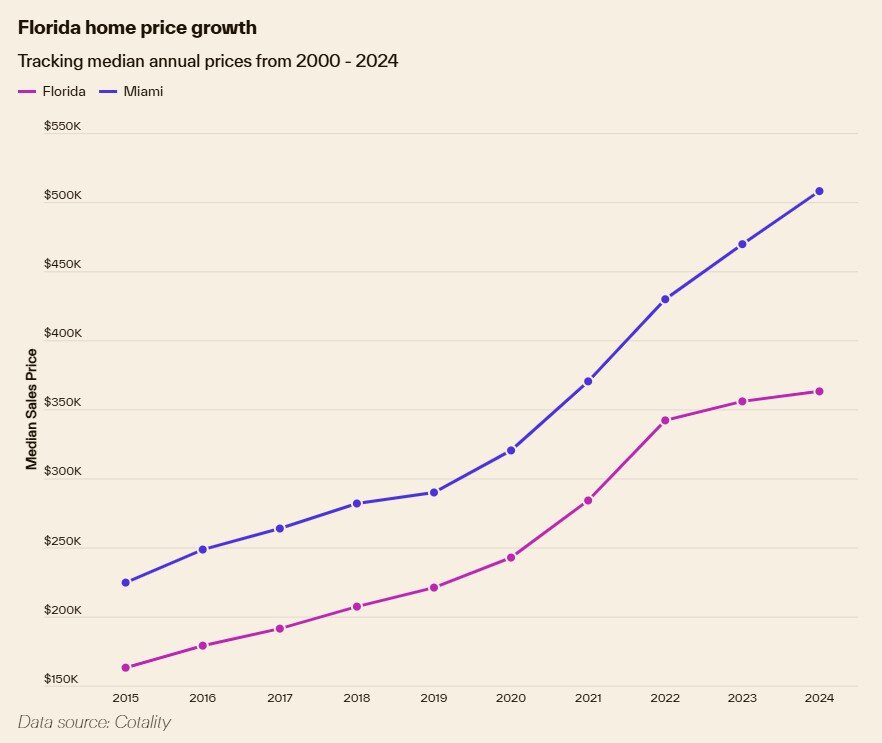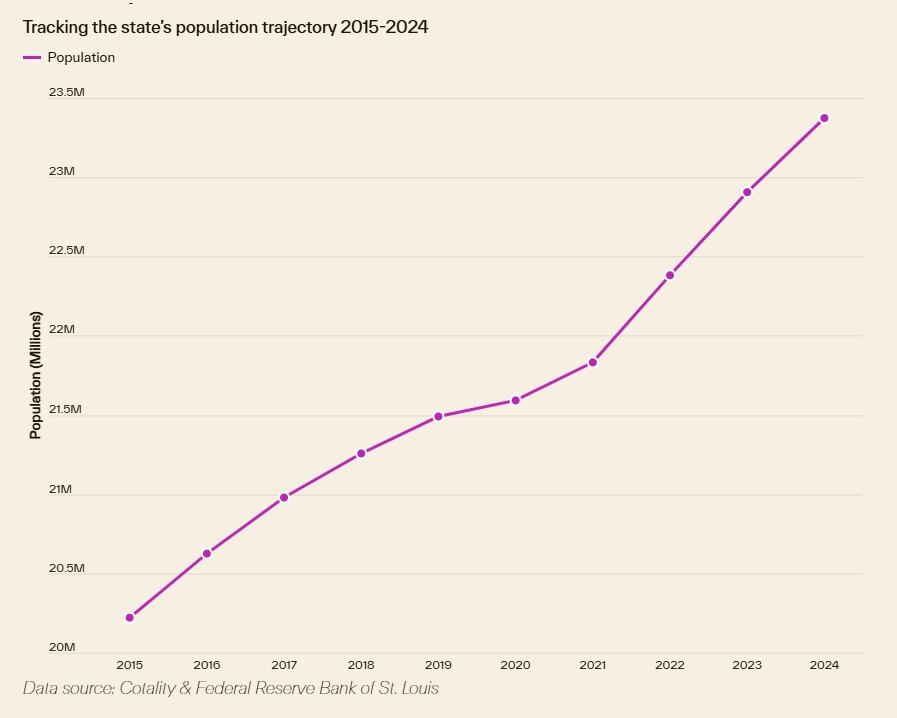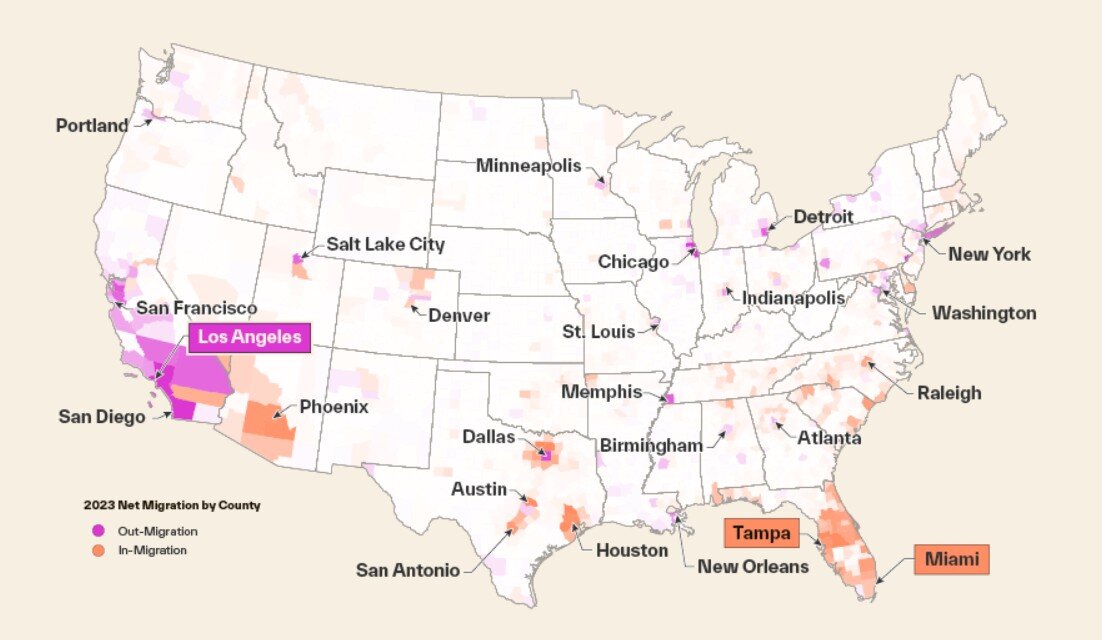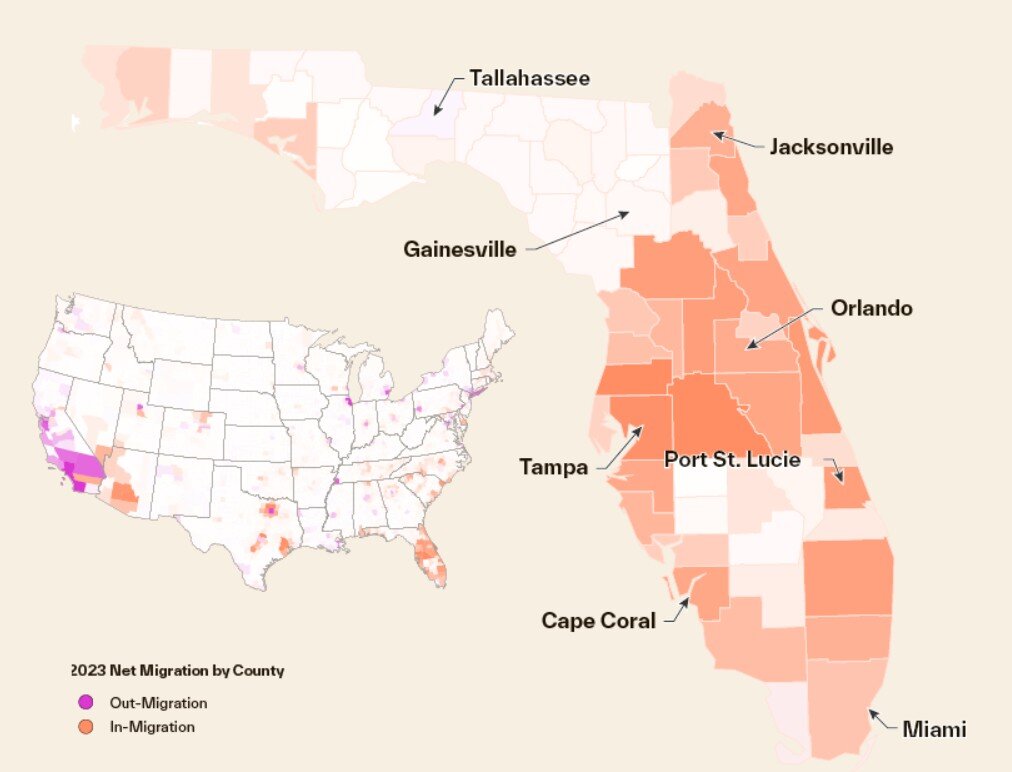Residential Real Estate News

Florida's California Moment: Skyrocketing Housing, HOA and Insurance Costs Take Center Stage in 2025
Residential News » Miami Edition | By Michael Gerrity | April 23, 2025 6:02 AM ET
Aging infrastructure and home affordability are rising challenges for Florida
For decades, Florida has served as a haven from high-tax, high-cost states -- attracting retirees, snowbirds, hourly workers, and increasingly, younger professionals priced out of other housing markets. From 2021 to 2023, nearly 2.76 million people relocated to the Sunshine State, propelling it to become the third most populous in the nation, according to real estate data firm Cotality. But Florida's reputation as a land of opportunity is being tested by a trio of challenges: rising home prices, eroding affordability, and mounting strain on infrastructure.
"Over the past 25 years, we've seen a significant increase in home prices, insurance premiums, and property taxes in Florida," says Dr. Selma Hepp, Chief Economist at Cotality. "Add to that the relentless pace of migration, which is putting pressure on public services and inflating costs across sectors, and we're seeing a tipping point. Many families are finding it harder to justify staying in the state."
It's a pattern that echoes California's experience: soaring housing costs, escalating insurance, and aging infrastructure eventually led to a population outflow. Florida, once viewed as a destination for relief and reinvention, is now seeing early signs of the same phenomenon -- a reversal driven by its own explosive growth. This special report by Cotality explores whether Florida's meteoric rise could ultimately sow the seeds of its undoing.
Is Florida Reaching Its Breaking Point?
Dr. Hepp tells The World Property Journal, "The state's steep home price increases, rising insurance premiums, and heightened hurricane risks are making people think twice. We're now seeing residents look toward other Southern states where affordability is more attainable, and economic opportunity is still strong -- the same factors that once made Florida so attractive."
Florida's surging popularity has become a double-edged sword. Its housing market, public infrastructure, and environmental resilience are being put to the test, and signs suggest that its long-standing appeal to homebuyers may be shifting.
Cotality's analysts point to two major risks shaping Florida's housing future: the growing connection between natural disasters, ballooning insurance costs, and dwindling affordability; and the increasing friction between rapid business growth and limited housing availability. Both trends are reshaping Florida's identity as a place to settle down.
The Migration Boom and Florida's Hidden Housing Costs
Florida's population surge hasn't happened in a vacuum -- it's driven by specific migration trends. Cotality's AI-powered data platform, which tracks 99.9% of U.S. residential properties, reveals who's moving to Florida and the ripple effects on local housing, infrastructure, and the economy.
While New York has long been a top source of incoming residents, 2023 saw California contribute 6% of new arrivals -- a notable shift from the West Coast toward Florida's economic and political climate. Georgia, Texas, and New Jersey also ranked among the top five origin states.
But the era of low-cost living that once defined Florida is fading. Newcomers often arrive with significant wealth, driving up home prices and pushing out younger, middle-income buyers. With baby boomers competing for homes using cash, affordability is increasingly out of reach for first-time buyers. Between 2018 and 2022, Cotality's data shows that home sales in Florida surpassed even the peak of the 2005 housing boom -- a sign of intense demand and limited supply.
Sign Up Free | The WPJ Weekly Newsletter
Relevant real estate news.
Actionable market intelligence.
Right to your inbox every week.
Real Estate Listings Showcase
Related News Stories
Residential Real Estate Headlines
- India Home Prices Nationwide Climbed 9 Percent Annually in 2024
- U.S. Home Remodeling Industry Sentiment Declines in Early 2025
- Canadian Home Sales Slide in February Amid U.S. Trade Tensions
- Americans Spent $603 Billion on Home Remodeling Projects in 2024
- U.S. Mortgage Demand Spikes 20 Percent in Early April as Rates Drop
- Las Vegas Area Home Prices Uptick 4.3 Percent Annually in March
- Single-Family Rent Growth in U.S. Trends Upward in 2025
- U.S. Mortgage Rates Tick Down Post Trump Tariffs Commencement
- President Trump's 'Liberation Day' Tariffs Potential Impact on the U.S. Housing and Mortgage Markets
- Baby Boomers Biggest Cohort of U.S. Home Buyers in 2025 as Millennials Decline
- U.S. Monthly Housing Payments Hit Record High in 2025
- U.S. Pending Home Sales Uptick in February
- Global Prime Residential Rent Slowdown Continued in Late 2024
- Ireland Home Price Inflation Hits 8 Year High in Early 2025
- Existing Home Sales in America Uptick in February
- Great Miami Area Residential Sales Decline 15 Percent Annually in February
- Mortgage Rates Uptick in Mid-March, Ending 9-Week Decline in U.S.
- World Property Ventures Builds the Future of Real Estate with New Funding Round
- U.S. Builder Sentiment Declines Amid Economic Uncertainty and Rising Costs
- Black Homeownership Rates in U.S. Enjoy Largest Annual Increase of All Racial Groups
- Wealthy Renters Are Taking Over More of the U.S. Rental Market
- If U.S. Congress Does Not Extend NFIP Soon, Thousands of Daily Home Closings Impacted
- U.S. Mortgage Applications Spike 11 Percent in Early March
- Greater Palm Beach Area Residential Sales Rise in Early 2025
- New Apartments in U.S. Are Leasing at Slowest Pace on Record
- U.S. Mortgage Rates Drop to 4 Month Low in March
- Overall U.S. Mortgage Delinquency Rates Dip in December
- New Tariffs on Canada, Mexico to Impact U.S. Homebuilder Input Costs
- Monaco's Property Market: A Tale of Two Cities
- U.S. Home Purchase Cancellations Surge, 1 in 7 Sales Getting Canceled
- U.S. Pending Home Sales Hit Historic Low in Early 2025
- Greater Miami Area Residential Sales Dip in January
- Governor DeSantis Supports Ending Property Taxes in Florida
- WPV Aims to Become the Berkshire Hathaway of Real Estate Tech
- U.S. Home Sales Slump Continues in January
- Average Americans Spend 38 Percent of Monthly Income on Mortgage Payments
- Switzerland's Safe-Haven Appeal Grows with World's Wealthy Homebuyers
- U.S. Builder Confidence Rapidly Declines in February
- Las Vegas Home Sales Rise 6.7 Percent Annually in January, Condo Sales Dip
- Homebuyer Demand in America Drops to 5-Year Low in Early 2025









